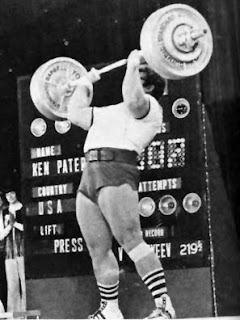When I was a child, I has three fantasies of physical prowess:
1. That I could beat my father at arm-wrestling.
2. That I would grow up to be a professional wrestler. My name would be the Judge...and I would play a heel who would sentence people to butt-kickings in the ring. My finishing move would be "The Scales of Justice." But that's for another blog...
 |
| Ivan and Nikita Koloff, c. 1985 |
3. That I would have a neck wider than my head.
Hey- these may sound strange, but they were MY fantasies! I never accomplished these feats, but along the way, I did play a lot of sports and grew into a pair of very solid, functional shoulders. I did this over the years mainly through one exercise- the Military Press. And this is exactly the topic today- building better shoulders through this most useful exercise.
I. Ditch the baggage of preconceived ideas.
 |
| Ken Patera pressing 463 lbs. |
Military presses sometimes get the rap for being "old school" or outdated.
 |
| Physical culture poster from the 1910s |
II. Setting up the movement
 |
| The bar's path and where the body is |
There's the very crucial idea about BALANCE in the military press.
Ideally, you'll perform the movement with an Olympic barbell, the seven-foot long instrument found in any commercial gym.
It's the most effective implement you can use to do the motion. It weighs 45lbs. when empty, and you load it accordingly when you need to increase the weight of the movement.
Dumbbells and resistance bands tend to diminish and distort the overhead pressing motion....so stick with the barbell.
You'll notice the illustrations and photos show the exerciser STANDING. Yes, indeed! Standing motions force the person working out to stabilize the movement with their body. A seat, bench, or machine lessens the "auto-balancing" effect. So...do the movement standing. It's better that way
I recommend using an empty bar initially. If you work on the mechanics with a light weight, the transition to using heavier weights with GOOD FORM later.
You should unrack the bar from a squat rack, back up a couple feet, and prepare to start.
III. Start lifting
YouTube primer on Military Pressing
This is one of the best videos I've seen on doing the movement well. The Cross Fit athlete doing these has terrific cadence, rhythm, mechanics, and body positioning. Here are some suggestions, in addition to the ones on the video:
1. After you unrack the barbell, tighten your glutes (butt) and latissimus Dorsi (upper back muscles) before starting your set
2. Position your wrists slightly in front of your elbows when holding the weight. Keep this wrist/shoulder positioning consistent
3. As you press the weight overhead, exhale AFTER the weight has moved beyond the top of the head. This synchronizes the right amount of tension, breath, and strength together.
4. You DON'T have to breathe on every repetition. I'm not recommending a Valsalva Maneuver here, but there IS something to the practice of breathing forcibly when you need it.
5. Finish strong! This means just to lock out your repetitions completely, each and every one.
IV. Don't do this!
 |
| David Rigert, USSR, 1972 |
V. Sets and Repetitions
This is a contentious topic for anyone involved in exercise. While I won't get into deeply technical arguments for or against any existing system for strength training, I'll say this: 2-4 sets of 8-15 repetitions works for almost everyone.
Below is a rubric for training ranges, based on what the exerciser is looking for. Remember, though- EVERYTHING works in exercise, just not forever. Everyone has their own geometry, their own likes and dislikes, and "best fits" with exercise. Find out what works for you!
Conclusion
Have fun. Push yourself hard. Listen to your body- it'll tell you when you've gone too far. Train smart. And do military presses. They are enjoying a Renaissance right now because of CrossFit's popularity, but they're the objectively best, most effective shoulder movement that there has ever been. They work well at building well-rounded shoulders and they stabilize the core.
They're the perfect movement for the person chasing physique goals, someone seeking personal records for maximum amount lifted, or just the person looking to get in better general shape. In other words, they work just as well for athletes as they do "dabblers."
I gotta say...there's something kind of heady about doing an overhead press with a good chunk of weight. It's almost a spiritual feeling. Like lifting the Rock of Gibraltar or the Stone of Sisyphus. It's a one of a kind feeling that has to experienced to really feel it.
Enjoy!
- Greg


Hi Greg! I found your article to be very interesting personally because I just joined a CrossFit gym two months ago and I'm doing a "Starting Strength" program. I haven't done military press yet myself, but it looks very similar to the shoulder presses that I do. I almost wrote my blog post on the benefits of weight training for women. I've seen more amazing changes in my body from lifting heavy weights than any amount of cardio I've ever done. So thanks for the interesting post. I liked the story at the beginning as well. It made it more personal as to why you like to lift. -Jenny Gordon
ReplyDelete